 |
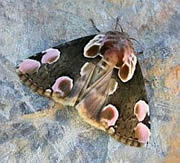 Peach Blossom
Peach Blossom
Thyatira batis
© Teresa Farino
Butterflies and Moths of the Picos de Europa - 2005 trip report
by Teresa Farino
9 - 16 July 2005
Five clients joined Teresa for this highly successful tour in the Picos de Europa, during which we
recorded 102 species of butterfly and more than 150 macromoths (both day-flying and in the moth trap).
Here we deal with the families in taxonomic order.
Butterflies
We observed all three Picos species of the Papilionidae - Swallowtail, Spanish Swallowtail and Apollo
- in reasonable numbers and across a wide range of habitats, although the Apollos were found only at
altitude. Among the Pieridae (11 species recorded), the most memorable were both male and female
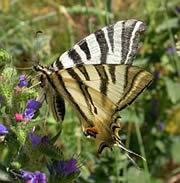 Spanish Swallowtail
Spanish Swallowtail
Iphiclides feisthamelii
© Teresa Farino
Mountain Clouded Yellows above Fuente Dé, with fair numbers of Wood Whites and Cleopatras and a few
Black-veined Whites throughout the week.
The Lycaenidae (30 species observed) were truly spectacular at this time of year. Beds of mint
along the streamsides in the higher-level meadows gave us superb views of nectaring coppers,
with Scarce, Sooty and Purple-edged particularly eye-catching, while Blue-spot Hairstreaks and
Mazarine Blues seemed to be particularly fond of the spiny flowers of Pyrenean Eryngo. At the top of
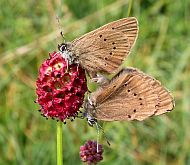 Mating Dusky Large Blues
Mating Dusky Large Blues
Maculinea nausithous
© Teresa Farino
the cable car we were delighted to encounter large numbers of mud-puddling male Gavarnie Blues,
which here belong to the Picos endemic subspecies asturiensis, while more Mediterranean habitats
at low altitude were the preferred haunt of Spanish Purple and False Ilex Hairstreaks and Long-tailed
and Lang's Short-tailed Blues. On heading south into the limestone plateaux of the Castilian meseta,
we also turned up Damon, Ripart's Anomalous, Meleager's and Spanish Chalk-hill Blues all of which are
more thermophilic species which don't occur in the Picos de Europa.
Two notable highlights in the Lycaenidae were the first records of White-letter Hairstreak for the
area of the Picos de Europa (albeit at the more southerly pass of Piedrasluengas), and the discovery
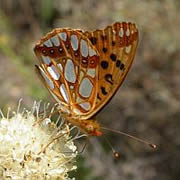 Queen of Spain fritillary
Queen of Spain fritillary
Issoria lathonia
© Teresa Farino
of a new colony of Dusky Large Blue for Spain, just of stone's throw from the National Park boundary,
both of which events were largely due to the extremely sharp eyes of Tony Butters.
Among the 24 species of Nymphalidae we encountered were a single, beautifully fresh Camberwell
Beauty, a lone individual of the summer's newly emerged population of Large Tortoiseshells, and just
one White Admiral. Much more abundant were the fritillaries, with Silver-washed seen every day in
good numbers, accompanied by an abundance of Dark Green, High Brown, Knapweed and Queen of Spain.
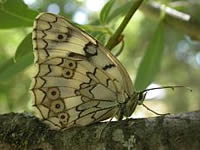 Esper's Marbled White
Esper's Marbled White
Melanargia russiae cleanthe
© Teresa Farino
More sporadic - and habitat specific - were the Spotted and Weaver's Fritillaries of the drier
lowlands, and the Small Pearl-bordered, Marbled and Lesser Marbled Fritillaries of the higher,
wetter meadows. Peacocks were unusually abundant this summer, and we came across Cardinals in a wide
range of habitats. In the Castilian Plains we also found good numbers of Twin-spot Fritillaries,
which again are not found in the Picos proper.
The Satyridae had not yet reached their peak diversity in the Picos de Europa at the time of this
tour, but even so we observed 23 species, with the rediscovery of a small colony of Woodland Brown
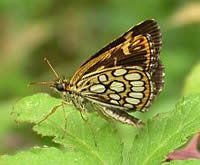 Large Chequered Skipper
Large Chequered Skipper
Heteropterus morpheus
© Teresa Farino
the most noteworthy event, although the abundance of the Picos endemic subspecies of Lefèbvre's
Ringlet (astur) at the top of the cable car came a close second. We also came across Chapman's
Ringlet - unique to mountain passes in the central and western Cordillera Cantábrica -
on two occasions, as well as some of the first Esper's Marbled Whites of the summer,
while our day in the Castilian Plains added Black Satyr (a non-Picos species), Spanish Heath,
Spanish Gatekeeper, Grayling and Great Banded Grayling to the list.
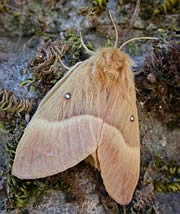 Oak Eggar
Oak Eggar
Lasiocampa quercus
© Teresa Farino
Of the 11 species of Hesperiidae (Skippers) we recorded, the highlight for Teresa was
undoubtedly her first ever Large Chequered Skipper in the Picos de Europa, with other species
of interest including large numbers of Lulworth Skippers and a few Marbled Skippers, the
latter a rather local and uncommon species across much of Europe today.
Moths
Every night during the tour we set out the moth trap (a Skinner trap powered by an 80W
Mercury Vapour Lamp) on the terrace of Teresa's house (520 metres above sea level), which
backs onto mixed evergreen and broad-leaved forest interspersed with haymeadows,
running up a river valley into mountains at about 1800 metres. Although the clear weather
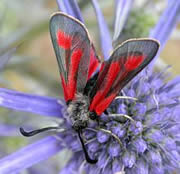 Zygaena contaminei peñalabrica
© Teresa Farino
meant that the mornings were rather cold, we recorded a good range of macro-moths, including
several new species for Teresa's Picos list. Micromoths were largely ignored on account of
the paucity of field guides covering this group in Spain, but we did record such rare UK
species as Pyralis lienigialis and Cynaeda dentalis. We also recorded day-flying moths
during our daily forays in search of butterflies.
Zygaena contaminei peñalabrica
© Teresa Farino
meant that the mornings were rather cold, we recorded a good range of macro-moths, including
several new species for Teresa's Picos list. Micromoths were largely ignored on account of
the paucity of field guides covering this group in Spain, but we did record such rare UK
species as Pyralis lienigialis and Cynaeda dentalis. We also recorded day-flying moths
during our daily forays in search of butterflies.
In the more primitive groups, we trapped two species of Cossidae - Goat and Leopard Moths -:
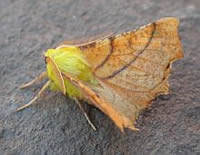 Canary-shouldered Thorn
Canary-shouldered Thorn
Ennomos alniaria
© Teresa Farino
just two individuals of the former, which is rare in Britain these days, and the latter in
some numbers, probably on account of the orchard just below the wall. The diurnal Fiery
Clearwing (a scarce British species) was the sole member of the Sesiidae recorded, but
we observed 6 species of the day-flying Zygaenidae (Burnet moths), including the rather distinctive
Zygaena contaminei peñalabrica at Piedrasluengas and Z. fausta in the Castilian Plains.
Two members of the Thyatiridae came to the light - Peach Blossom and Buff Arches - and we
managed to identify 31 species of the Geometridae, although this is another group which is
poorly represented in the way of identification books in Spain.
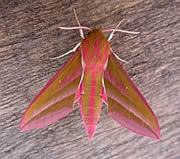 Elephant Hawkmoth
Elephant Hawkmoth
Deilephila elpenor
© Teresa Farino
Among this latter we trapped
a number of British rarities, including Horse Chestnut, Sussex Emerald, Portland Ribbon Wave
and The Mocha, but by far-more eye-catching were more commonplace species such as Peppered Moth,
Canary-shouldered Thorn, Swallow-tailed Moth, Blood-vein and The Vestal. Day-flying geometrids
included Orange Moth and Chimney Sweeper.
The bigger-bodied moths appeared in relatively low numbers, with just four species of
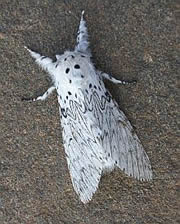 Lesser Puss Moth
Lesser Puss Moth
Cerura erminea
© Teresa Farino
the Lasiocampidae recorded: Oak Eggar at rest on a wall in Beges, plus the non-British Cork Oak Lappet (Phyllodesma suberifolia), The Lappet (up to five individuals
per night) and The Drinker in the trap. Of the hawk-moths (Sphingidae), we observed a rather disappointing five species only:
the day-flying Hummingbird Hawkmoth in some abundance and in most habitats, plus Poplar, Striped and Elephant Hawkmoths at light,
as well as the Southern Pine Hawkmoth (Sphinx (Hyloicus) maurorum).
The Notodontidae were represented by nine species, all at light, including the rather handsome
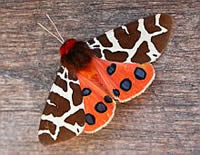 Garden Tiger
Garden Tiger
Arctia caja
© Teresa Farino
Lesser Puss Moth (Cerura erminea) and Lobster Moth, as well as Iron, Pebble, Coxcomb and Three-humped Prominents (the latter a migrant to the UK), while just one
member of the Thaumetopoeidae was recorded: the dreaded Pine Processionary. Several notable species in the Lymantriidae
(5 species) were trapped, including Dark Tussock, which is extremely rare in Spain, and was new for Teresa in the Picos
de Europa, as well as another addition to the list: the rather delicate Gypsy Rose (Ocneria rubea).
Perhaps the most colourful group of moths in Europe is the Arctiidae (tiger moths),
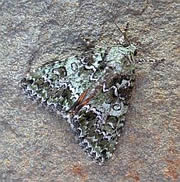 Guernsey Underwing
Guernsey Underwing
Polyphaenis viridis
© Teresa Farino
and during the week's tour we recorded 12 species in this family, including the day-flying
Scarlet Tiger and Feathered Footman (very rare in Britain), with Dew Moth being recorded both
in the trap and during the day at 2000 metres above Fuente Dé. In the past, our high-altitude
dew moths were separated as Setina cantabrica, but in recent studies they have been lumped in
with the British species S. irrorella. In addition, although Jersey Tiger (one of the few moths
to be protected by Annex II of the Habitats Directive) is an abundant species at light in the
Picos a little later in the season, our only specimen of the week was disturbed during the day.
Among the other arctiid moths observed in the trap were the non-British Glaucous Muslin (Paidia rica),
both male and female Four-spotted Footman (rare today in the UK, but present in huge numbers here,
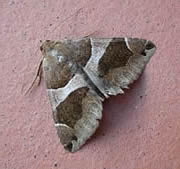 The Passenger
The Passenger
Dysgonia algira
© Teresa Farino
especially on the 15 July, when more than 500 individuals were recorded) and small numbers of the
gorgeous Garden Tiger.
And last, but not least, the Noctuidae, of which we positively identified
73 species during the week, including several additions to the Picos list: Buttoned Snout and
Light Crimson Underwing, both of which are scarce in Britain, and Double Dart. Other British
rarities included Heart Moth, Small Ranunculus (extant populations only recently rediscovered in
the UK, having been thought extinct), White-point and L-album Wainscot, as well as species whose
only UK populations are in the Channel Islands, such as Guernsey Underwing and Orache Moth, the
latter formerly resident in the UK but now extinct.
We also recorded a number of species which occur in the UK only as migrants, such as
Plumed Fan-foot, Oak Yellow Underwing (maximum 53 individuals on 15 July), The Passenger,
Tree Lichen Beauty, Dewick's Plusia, Pale-shouldered Cloud, The Latin and White Speck.
Day-flying noctuids included Pale Shoulder and Silver Y (both immigrant to the UK, although
the former is resident in Jersey), plus Dusky Sallow in the Castilian Plains.
Important note: in Spain it is ILLEGAL to use a butterfly net or moth trap without a permit from
the relevant authorities, even if you do not take specimens.
Teresa Farino
Natural history tours in the Picos de Europa:
Butterflies and Moths of the Southern Valleys of the Picos de Europa
Natural History of the Picos de Europa and Páramos of Northern Castile
A Family Wildlife Holiday in the Picos de Europa
A Feast of Flowers - botanical trips to the Picos de Europa
Daily wildlife excursions in the Picos de Europa
Reports from past trips to the Picos de Europa:
Butterflies & moths of the Picos de Europa - 2008 trip report
Butterflies & moths of the Picos de Europa - 2006 trip report
Butterflies & moths of the Picos de Europa - 2005 trip report
A Feast of Flowers in the Picos de Europa - 2009 trip report
BSBI Botanical Tour of the Picos de Europa - 2004 trip report
Related information:
Picos de Europa - a naturalist's paradise
Complete list of butterflies for the Picos de Europa
Read about Teresa Farino
Wildlife holidays and natural history tours in Spain & Portugal
|